Drag the Significant Asian Homo Erectus Finds to the Locations Where They Were Found.
By 1.9 million years ago, some of the early transitional humans had evolved into a new, fully human species in Africa. Most paleoanthropologists refer to them as Homo erectus ![]() (literally "upright human"). However, a few researchers split them into two species-- Homo ergaster
(literally "upright human"). However, a few researchers split them into two species-- Homo ergaster ![]() (literally "working human") and Homo erectus. The ergaster fossils were presumably somewhat earlier and have been found for the most part in Africa. The erectus discoveries have been found widespread in Africa, Asia, and Europe. In this tutorial, ergaster and erectus will be considered one species--Homo erectus .
(literally "working human") and Homo erectus. The ergaster fossils were presumably somewhat earlier and have been found for the most part in Africa. The erectus discoveries have been found widespread in Africa, Asia, and Europe. In this tutorial, ergaster and erectus will be considered one species--Homo erectus .
Homo erectus were very successful in creating cultural technologies that allowed them to adapt to new environmental opportunities. They were true pioneers in developing human culture and in expanding their geographic range beyond Africa to populate tropical and subtropical zones elsewhere in the Old World. This territorial expansion most likely began around 1.8-1.7 million years ago, coinciding with progressively cooler global temperatures. Surprisingly, however, Homo erectus remained little changed anatomically until about 800,000 years ago. After that time, there apparently were evolutionary developments in features of the head that would become characteristic of modern humans. By half a million years ago, some Homo erectus were able to move into the seasonally cold temperate zones of Asia and Europe. This migration was made possible by greater intelligence and new cultural technologies, probably including better hunting skills and the ability to create fire.
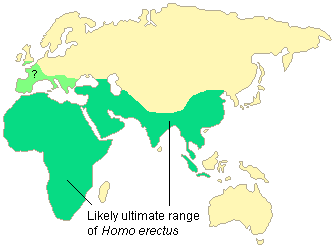
Evolutionary Relationships
The earliest Homo erectus were contemporaries of the late Homo habilis in East Africa for several hundred thousand years. This suggests that the immediate ancestor of Homo erectus was an early Homo habilis or possibly another yet to be discovered species of early humans. Homo erectus was a very successful human species, lasting at least 1.5 million years, though their numbers apparently remained relatively low. Some of them eventually evolved into our species, Homo sapiens ![]() . That evolutionary transition was well under way by 400,000 years ago but was not complete until 200,000-100,000 years ago and possibly even later in some regions.
. That evolutionary transition was well under way by 400,000 years ago but was not complete until 200,000-100,000 years ago and possibly even later in some regions.
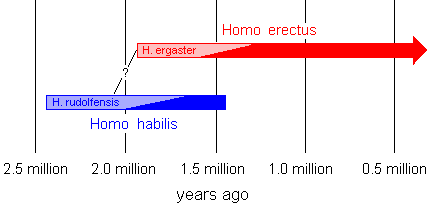
History of Discovery
| | |
| Eugene Dubois (1858-1940) | |
In the late 19th century, our knowledge of human fossil ancestors did not go back beyond that of the Neandertals in Europe, less than 100,000 years ago, and little was known about them. There was no inkling of our much earlier ancestors in Africa. A few scientists speculated that the most ancient humans would be found somewhere in tropical regions of East Asia. One of the people who held this view was a Dutch anatomist and medical doctor named Eugene Dubois ![]() . Late in 1887, he went to the Dutch East Indies (now Indonesia) as a military doctor. This job allowed him enough spare time to pursue his passion, the search for early human fossils. He first explored the big island of Sumatra. Excavating in several caves, he found a hominid jaw fragment in 1890. However, this was not convincing evidence of early human ancestry. He then moved on to Java. During excavations in the eastern part of that island in 1891-1892, he recovered a Homo erectus brain case and femur
. Late in 1887, he went to the Dutch East Indies (now Indonesia) as a military doctor. This job allowed him enough spare time to pursue his passion, the search for early human fossils. He first explored the big island of Sumatra. Excavating in several caves, he found a hominid jaw fragment in 1890. However, this was not convincing evidence of early human ancestry. He then moved on to Java. During excavations in the eastern part of that island in 1891-1892, he recovered a Homo erectus brain case and femur ![]() (upper leg bone). Since he had discovered an unknown species, he took the liberty of naming it in an 1894 publication. He called it Pithecanthropus erectus
(upper leg bone). Since he had discovered an unknown species, he took the liberty of naming it in an 1894 publication. He called it Pithecanthropus erectus ![]() (literally "ape man who stands erect"). He returned to the Netherlands with his fossils in 1895 and proclaimed them to be from our earliest ancestor. Unfortunately for Dubois, most of the leading paleontologists of his day were not convinced.
(literally "ape man who stands erect"). He returned to the Netherlands with his fossils in 1895 and proclaimed them to be from our earliest ancestor. Unfortunately for Dubois, most of the leading paleontologists of his day were not convinced.
Dubois' claims for his Java Homo erectus finds were not widely accepted until the 1930's, when the German/Dutch paleontologist Gustav von Koenigswald made similar discoveries in the Dutch East Indies. By that time, there had also been even more convincing discoveries of Homo erectus in China. Dubois, now in his 70's, stubbornly refused to accept any of these fossils as being from the same species as his "Java Man" specimens. He died at the outset of World War II, apparently as a rather lonely maverick scientist frustrated by the inability to convince many people that his conclusions had been correct.
Dating the Java Homo erectus fossils has been difficult. In the past, it was generally accepted that most of these bones are 700,000-200,000 years old, based roughly on what was the presumed date for the geological strata in which they were found. In 1994, however, radiometric dating of sand particles attached to two of the fossils indicated that they were actually 1.8 and 1.6 million years old. These dates indicate that some Homo erectus left Africa soon after they evolved from early transitional humans.
In 1911, a revolution in China overthrew the last emperor of the Manchu Dynasty and set up a Western-style republic under the leadership of the American-educated Dr. Sun Yat-Sen. In imitation of western nations, the Geological Survey of China was established in 1917 with a Swedish geologist named J. Gunnar Anderson as its advisor. Among the many tasks of the Survey was the search for the source of "dragon bones." This is a Chinese generic term for the fossil bones that end up in apothecary shops as medicines. They are still popularly used in a ground up form for healing wounds and fractures and treating cramps and dizziness. Some older men in China use them as sexual stimulants, though they are being replaced by modern drugs such as Cialis, Viagra, and Levitra.
 | |
| Davidson Black (1884-1934) | |
In 1921, Gunnar Anderson discovered that one of the important sources of "dragon bones" in North China was an abandoned limestone quarry near the village of Zhoukoudian ![]() . This was only a day's drive over rough dirt roads from Beijing. In 1927, a fossil was found in an ancient cave at the base of the quarry that turned out to be a Homo erectus molar tooth. It was examined by Davidson Black , a Canadian anatomy professor at Peking Union Medical College. He identified the tooth as being from an earlier species of human which he named Sinanthropus pekinensis
. This was only a day's drive over rough dirt roads from Beijing. In 1927, a fossil was found in an ancient cave at the base of the quarry that turned out to be a Homo erectus molar tooth. It was examined by Davidson Black , a Canadian anatomy professor at Peking Union Medical College. He identified the tooth as being from an earlier species of human which he named Sinanthropus pekinensis ![]() (literally "Chinese man from Peking", or Beijing as it is now called). This discovery sparked 10 years of intense excavations at Zhoukoudian by Anderson, Black, and others (especially Pei Wenshong after 1929 and Franz Weidenreich in the mid-1930's). The bones of 50 individual Homo erectus were eventually found there.
(literally "Chinese man from Peking", or Beijing as it is now called). This discovery sparked 10 years of intense excavations at Zhoukoudian by Anderson, Black, and others (especially Pei Wenshong after 1929 and Franz Weidenreich in the mid-1930's). The bones of 50 individual Homo erectus were eventually found there.
 | |
| "Peking Man" skull | |
The Homo erectus skeletal evidence at the "Peking Man" site of Zhoukoudian is especially important because it is from a population of men, women, and children rather than just a single individual. There was considerable sexual dimorphism and individual variability. The human remains were associated with large quantities of animal bones that apparently were mostly food refuse, though many of them had been chewed by large carnivores and may have ended up in the cave complex as a result of their activities. A few of the bones had been burned in a way that suggests cooking. In addition, more than 100,000 stone, bone, antler, and horn tools were excavated. The cave was intermittently occupied by late Homo erectus for around 300,000 years, beginning around 780,000 years ago.
With the exception of two teeth, all of the Homo erectus bones from Zhoukoudian were lost in the chaos of late 1941 when the Japanese Army invaded Beijing and other urban centers in eastern China. There have been a number of intriguing guesses about what happened to the bones. The last time they were accounted for was when they were turned over to a U.S. Marine detachment, placed in wooden foot-lockers, and possibly taken 140 miles from Beijing to the American Camp Holcomb. They were to be transported by ship to the U.S. for safety on an American freighter named the President Harrison. However, after the U.S. entered the war on December 7, 1941, Japanese forces quickly seized Camp Holcomb. At that point in time, the Zhoukoudian fossils disappeared and have never reappeared. In 1949, the Peoples Republic of China established a $100,000 reward for their return. Unfortunately, it has not been claimed. The only surviving bones were the two teeth that had not been turned over to the Marines in 1941.
The loss to science of the Zhoukoudian bones was not as great as it may initially seem. Earlier, they had been measured, photographed, and excellent casts of them had been successfully sent to the U.S. by Franz Weidenreich where they were kept safe during World War II. In addition, other Homo erectus skeletal material has been excavated in China since the mid 1960's. Most notably are the finds that were recovered from Lantian County, Shensi Province. These fossils from several Chinese sites date to at least 800,000 years ago.
 | |
| "Turkana Boy" | |
In 1960, Louis and Mary Leakey found a 1.25 million year old Homo erectus partial cranium at Olduvai Gorge . Subsequently, more Homo erectus fossils were discovered there and at other sites in East, South, and Northwest Africa. The oldest known Homo erectus date to nearly 2 million years ago in East Africa. This strongly suggests that Homo erectus originated there. In 1984, Richard Leakey's team working at Nariokotome on the western side of Lake Turkana found a nearly complete Homo erectus skeleton of an 8-12 year old boy dating to 1.6 million years ago. It is usually referred to as the " Turkana Boy ." The significance of this discovery will be discussed below.
Three surprisingly early Homo erectus skulls were found during the 1990's on the fringes of Eastern Europe at Dmanisi in the Republic of Georgia. They date to 1.75 million years ago and look very much like the earliest Homo erectus from Africa--i.e., those that have been classified by some researchers as Homo ergaster. This discovery lends credence to the 1.8 and 1.6 million year old dates for Homo erectus from Java and to an early rather than late Homo erectus expansion out of Africa.
Homo erectus-like bones were also discovered during the 1990's from several other sites in Western Europe and Africa that date 800,000-400,000 years ago. It has been difficult to assign these fossils to specific species due to the fact that they have characteristics of both Homo erectus and more recent human species. Some paleoanthropologists consider them to be late transitional Homo erectus. Others now suggest that they are Homo heidelbergensis , a subsequent species that descended from Homo erectus and preceded Neandertals and other archaic humans. That is the approach taken in this tutorial series. This particular difference of species assignment is not particularly important and it does not detract from our growing understanding of the broad evolutionary trends. It is a result of our evolving conceptualization of the past as more data become available. It also partly reflects the fact that the picture of human evolution looks somewhat dissimilar in different regions of the World. It is now becoming clear that our evolution was not as straight forward as it once was commonly thought. Humans in some areas lagged behind. This was particularly true on some islands of Indonesia. At Ngandong on Java, for instance, Homo erectus may have survived to 53,000 years ago or even somewhat later.
| Important Homo erectus Sites | |||||||||||||||||||||||||||||||||||||||||||||||||||||||||||||||||||||||||
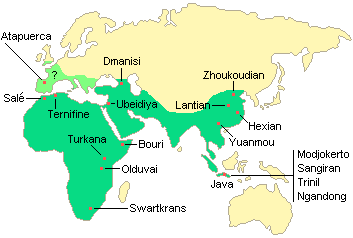 |
| ||||||||||||||||||||||||||||||||||||||||||||||||||||||||||||||||||||||||
| Note: Several human fossils dating 800,000-400,000 years ago are controversial. They are classified as Homo erectus by some researchers and Homo heidelbergensis (a later human species) by others. They will be presented in the next tutorial of this series. Note: It is likely that Homo erectus reached Java and other Indonesian islands during glacial periods when sea levels were low enough to create a land connection with the Southeast Asian mainland. |
Homo erectus Anatomy
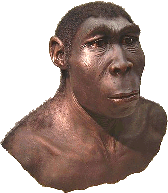 | |
| Homo erectus |
Below the neck, Homo erectus were anatomically much like modern humans. Their arm and leg bones were essentially the same as modern people in shape and relative proportions. This strongly supports the view that they were equal to us in their ability to walk and run bipedally. However, their leg bones were apparently denser than ours. This may be partly a result of developmental adjustment differences. Unlike us, these early humans did not spend much of their lives sitting behind desks or on a sofa watching TV. They were probably much more active throughout the day seeking food.
Their legs would have made Homo erectus efficient long distance runners like modern humans. It has been suggested that this capability would have allowed them to run down small and even medium size game animals on the tropical savannas of East Africa. If this was the case, it is also likely that they were largely hairless by this time. Bodies with little hair are more efficient at remaining cool via the evaporation of sweat during times of heavy exertion. Four legged mammals primarily cool their bodies by panting. Because they are unable to pant while galloping, they readily overheat in hot weather. As a consequence, they cannot run long distances without collapsing from heat exhaustion. This gives human hunters a decisive advantage when chasing them.
It also has been suggested that the pelvis ![]() in early Homo erectus may have been a bit narrower than in modern humans, which would require the infant brain to be smaller at birth and to then undergo considerable growth in childhood. However, we must be careful to not make too much of these differences because the number of existing specimens is low and there were minor regional variations as well. This becomes apparent especially when comparing Homo erectus from East Asia and Africa.
in early Homo erectus may have been a bit narrower than in modern humans, which would require the infant brain to be smaller at birth and to then undergo considerable growth in childhood. However, we must be careful to not make too much of these differences because the number of existing specimens is low and there were minor regional variations as well. This becomes apparent especially when comparing Homo erectus from East Asia and Africa.
With the evolution of Homo erectus, there was a significant increase in body size compared to earlier hominids. Past estimates of Homo erectus stature frequently were in the 5-5� feet (152-168 cm) range for adult males and around 88-150 pounds (40-68 kg). The discovery of the "Turkana Boy" in 1984 brought this into question. This is not only the most complete specimen of this species so far discovered, but it is one of the earliest. The boy was only 8-12 years old when he died but already 5 feet 3 inches (160 cm) tall. If he had lived to adulthood, he very likely would have grown to 6 feet (180 cm), assuming that Homo erectus growth patterns were similar to ours. As the number of nearly complete Homo erectus skeletons increases in the future, a clearer understanding of the range of their stature and body shape will likely emerge.
Homo erectus heads were strikingly different from ours in shape. They had relatively strong muscles on the back of their necks. Their foreheads were shallow, sloping back from very prominent bony brow ridges (i.e., supraorbital tori ![]() ). Compared to modern humans, the Homo erectus brain case was more elongated from front to back and less spherical. As a consequence, the frontal and temporal lobes of their brains were narrower, suggesting that they would have had somewhat lower mental ability.
). Compared to modern humans, the Homo erectus brain case was more elongated from front to back and less spherical. As a consequence, the frontal and temporal lobes of their brains were narrower, suggesting that they would have had somewhat lower mental ability.
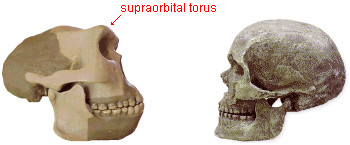 | |
| Homo erectus (from Java) | Homo sapiens (modern human) |
 | |
| shovel-shaped incisors | |
The adult Homo erectus brain size ranged from around 750 to 1250 cm 3 , averaging about 930 cm 3 . This was only around 69% the size of modern human brains on average but 50% larger than Homo habilis. The upper end of the Homo erectus brain size range overlapped that of modern people. However, the larger brained Homo erectus mostly were relatively late in time and are considered by some paleoanthropologists to be a more recent human species (Homo heidelbergensis or early archaic humans).
Homo erectus teeth were generally intermediate between modern humans and the australopithecines in shape and size. The teeth of later Homo erectus were generally smaller than the earlier members of this species. This was particularly true of molars. This evolutionary trend probably reflects a progressive change in diet to softer foods, including more meat and eventually cooked food. The incisor teeth of Homo erectus generally have a "scooped out" appearance on the tongue side. These "shovel-shaped" incisors are also found among many Asians and Native Americans today.
It is likely that increased meat consumption had a significant impact on the biological success of early humans. It provided the calories in a more easily digestible, concentrated form needed to maintain larger brains. The additional useable calories also made it possible for women to have shorter time periods between pregnancies and to subsequently give birth to more children during their reproductive years. As a result, there was an acceleration of human population growth which was very likely an important contributing factor in the spread of people out of Africa and into Asia and Europe for the first time.
Food For Thought: Meat-Based Diet Made Us Smarter--audio recording of an NPR interview with
anthropologists Leslie Aiello and Richard Wrangham concerning the relationship between switching
from a predominantly vegetable diet to one that contains large amounts of meat and the evolution of
large human brains. This link takes you to an external website. To return here, you must click the
"back" button on your browser program. (length = 7 mins, 46 secs)
Homo floresiensis
In 2003, a team of Australian paleoanthropologists led by Peter Brown discovered a skeleton from what may be a dwarf Homo erectus or related species that lived until 18,000 years ago on Flores Island, Indonesia. This 30 year old adult female was only about 3 feet 6 inches tall (106 cm), 66 pounds (30 kg), and had a brain size of 380 cm 3 (like those of australopithecines, barely 1/3 as big as modern human brains). This find implies that a population of exceptionally small Homo erectus or Homo erectus-derived humans survived on this relatively isolated island east of Java until far later than previously believed. Brown refers to this new discovery as Homo floresiensis ![]() . The bones of 8 additional individuals of this cave dwelling population were subsequently found on Flores Island.
. The bones of 8 additional individuals of this cave dwelling population were subsequently found on Flores Island.
At present, there is no clear consensus among paleoanthropologists as to the place of floresiensis in human evolution. Peter Brown and his colleague, Michael Norwood, suggest that floresiensis may have been a descendent of normal size Homo erectus who arrived in this area of Indonesia about 800,000 years ago or even earlier and that they became small as a result of a well known biological phenomenon referred to as "island dwarfing". They also believe that floresiensis may have survived on the island until a devastating volcano wiped them out, along with dwarf elephants, around 12,000 years ago. Critics suggest that the Flores Island dwarfs were, in fact, modern people who suffered from microcephaly, a pituitary gland disorder known as Laron syndrome, or hypothyroidism due to a lack of iodine in their diet.
The short video clip and the narrated slide show linked below will help you get a better understanding of this intriguing discovery.
Just how long humans have been on Flores Island is not clear. The volcanic ash layer above several simple flake artifacts found there has been dated with the argon/argon radiometric method to 1.08-1.02 million years ago. Presumably, this sets a minimum age for Homo floresiensis or their predecessors on the island.
NEWS: In the August 9, 2007 issue of Nature, Fred Spoor et.al., reported that a 1.44 million year old Homo habilis fossil was found at the Koobi Fora Formation east of Lake Turkana in Kenya. If this date proves to be reliable, it will confirm that Homo habilis lived until several hundred thousand years later than previously assumed. It also provides additional support for the assumption that Homo habilis was a contemporary of early Homo erectus rather than only a predecessor.
NEWS: In the February 27, 2009 issue of Science, Matthew Bennett et.al., reported the discovery of 2 sets of 1.51-1.53 million year old Homo erectus footprints near Lleret, Kenya. These prints are said to be essentially like those of modern humans.
NEWS: In the March 11, 2009 issue of Nature, Guanjun Shen et.al., reported that a joint Chinese and American research team was able to date the lower occupation levels at Zhoukoudian to 680,000-780,000 years ago using a new radiometric method based on the decay of aluminum and beryllium isotopes ( 26 Al and 10 Be) found in quartz grains. These dates place Homo erectus at Zhoukoudian around 200,000 years earlier than previously thought. It also establishes that they were present at the time of a mild glacial period.
NEWS: In the May 7, 2009 issue of Nature, W. L. Jungers et.al., reported that the feet of Homo floresiensis were relatively long with stubby big toes and no arches. This means that their feet had a combination of human and early hominin traits and implies that their gait was not as efficient as that of modern humans for long distance walking.
Copyright � 1999-2013 by Dennis O'Neil. All rights reserved.
illustration credits
Drag the Significant Asian Homo Erectus Finds to the Locations Where They Were Found.
Source: https://www2.palomar.edu/anthro/homo/homo_2.htm



Komentar
Posting Komentar